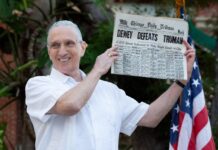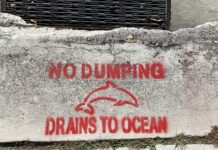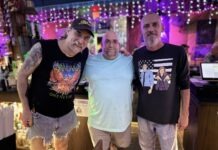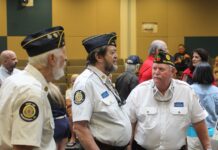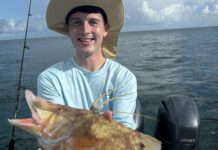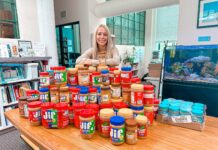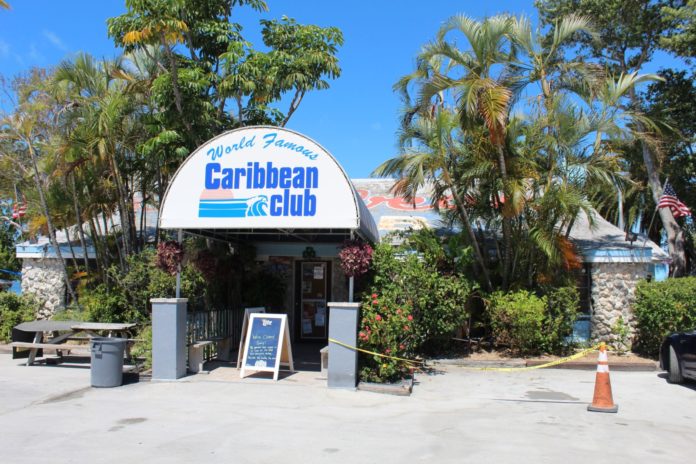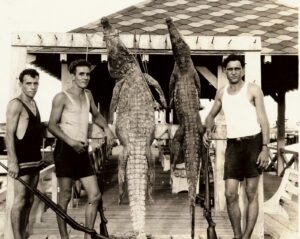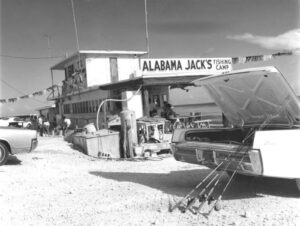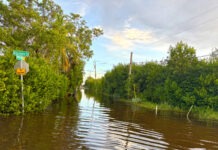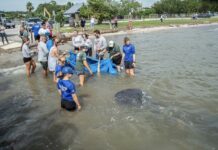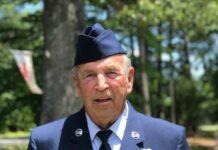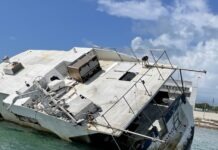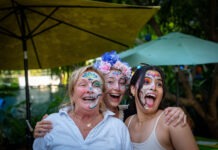There is a bar on Islamorada’s Windley Key with a sign declaring “the oldest most established liquor license in the Keys.” Without even considering some of the older watering holes in Key West, Key Largo’s Caribbean Club could challenge the claim. According to the Key West Citizen, Tom Hanley applied for a liquor license for Rock Harbor’s Caribbean Club in 1935. It is an odd year, a premature year, as the construction of the legendary club did not begin until 1938.
More generally associated with mainland developments like Miami Beach, Carl Fisher developed the property. However, broke and in poor health, he began developing the last project of his career, a private yacht club established on some property he owned on Key Largo. On July 12, 1938, Fisher was issued a “war department permit” authorizing him to build the following: a bulkhead, wharf, swimming enclosure, and an aquarium.
A clubhouse for the yacht club was also built, and, in a Miami News article dated February 8, 1939, it was announced that Ray Harris would be the steward at “Fisher’s new fishing club down at Key Largo – the Caribbean club. It is still in the throes of being built but should soon be ready.” Harris previously worked at a private club Fisher developed in 1922 on Adams Key called the Cocolobo Club. Adams Key is one of the northern keys and is today encompassed by Biscayne National Park.
In March 1939, Fisher filed a petition requesting permission to lengthen the club’s pier of “rock filled cribs of railroad ties” from 75 to 90 feet. Four months later, on July 15, 1939, Carl Fisher suffered a stomach hemorrhage and died in a hospital on Miami Beach, an island he began developing circa 1910. He was 65 years of age.
The Caribbean Club first opened its doors for business in January 1940, with Tom Hanley as the manager and Ray Harris working his culinary magic in the kitchen. Fisher did not own the club. It was deeded to the ownership of its esteemed directors: P.H. Arthur, Philo M. Gelatt, N. Vernon Hawthorne, John Oliver LaGorce, Daniel J. Mahoney, Hugh M. Matheson, William W. Muir, Thomas J. Pancoast, F. Lowrey Wall, and C. W. Chase. P.H Arthur was the club president, and Hugh M. Matheson the commodore.
The club sold in 1945 and, according to a deed made official by an indenture dated May 24, 1945, the deal was made between: “Caribbean Club (formerly named Key Largo Yacht & Fishing Club) a social club not for profit organized and existing under the laws of the State of Florida, party of the first part, and Right Reverend William Barry as Pastor of St. Patrick’s Parish, Miami Beach, Florida, party of the second part.”
Carl Fisher donated five polo stables to William Barry and St. Patrick’s in 1926, used for church services and classrooms for its school. Barry received the property with “all improvements in or about said premises except for the following articles of personal property: The painting approximately eight feet in length and breadth, the stuffed fish head, the members flags, the elephant foot, and the bronze membership plate.”
1945 appeared to be a popular year for the club’s property transactions. In May 1945, it was reported that Fred Dion purchased the Caribbean Club for $25,000. In December, the club was advertised for sale in the classifieds, with Tom Hanley identified as the club’s operator.
In most stories, Hanley is the owner, too. Hanley continued to develop the property and added a six-room hotel wing. He also offered gambling during the winter tourist season – unless the police happened to be nosing around.
Of course, the story everyone talks about is whether or not the Humphrey Bogart and Lauren Bacall classic Key Largo was filmed at the Caribbean Club. According to stories written by the people involved with the movie or those writing about them, it was not. However, the Caribbean Club did play a significant role during pre-production.
The film was adapted from the 1939 Maxwell Anderson play of the same name. John Huston, the director, liked the title but not the content, so he hired screenwriter Richard Brooks to rework the screenplay to better fit his vision. For inspiration, Huston brought Brooks to Key Largo, where the two men were guests of Mr. Hanley’s at the Caribbean Club. Though the club was officially closed for the summer, Hanley brought in help to cook for them and keep their rooms clean. He also brought in gaming tables where Huston and Brooks spent time gambling.
Before they left, Huston had allegedly lost about $25,000 playing craps and roulette, and Brooks gambled away around $6,000 or the money he was paid to rewrite the screenplay.
On the day they left the club and drove home to the mainland, they spent a little more time at Hanley’s tables. While they gambled, a storm was building. By the time they left, both men had managed to win back a good chunk of their losses. Also, with the weather outside storming, parts of the road were underwater.
Of course, the big winner was the Caribbean Club, which became world-famous and is an iconic Florida Keys roadside attraction, still.

